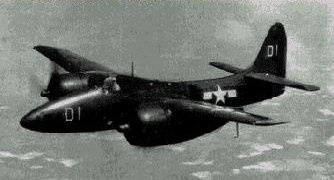Grumman F7F Tigercat
United States | Bell P-39 | Bell P-59 | Bell P-63 | Brewster F2A | P-36 Hawk | P-40 Warhawk | F4F Wildcat | F6F Hellcat | F7F Tigercat | F8F Bearcat | P-38 Lightning | Lockheed P-80 | P-51 Mustang | P-61 Black Widow | P-47 Thunderbolt | F4U Corsair
F7F Tigercat
Ordered on the same day as the F6F Hellcat prototypes in June 1941 the F7F was one of the boldest designs in the history of combat aircraft. During the preceeding years the US navy had keenly studied air war in Europe and noted that the things that appeared to count were the obvious ones; engine power, armament, and protective armour and self sealing fuel tanks. At a time when the average US Navy fighter had 1,000hp and two machine guns, the Bereau of Aeronautics asked Grumman to build a fighter with more than 4,000hp and a weight of fire more than 200 times as great. The company had embarked on a venture along these lines in 1938 with the XF5F, which remained a one-off prototype that was judged not worth the cost and incompatible with Navy carriers. In contrast, the F7F was planned on a basis of knowledge and though dramatically heavier and faster than any previous carrier aircraft it was matched with the deck of the large Midway-class carriers then under construction. Most, however, were ordered for the US Marine Corps for use from land. *
They arrived on the battle fronts in 1944, and used often as a night fighter. Many of them were given radar in the nose instead of guns and an observers seat in the rear. Only a few were ever used off aircraft carriers. What ended the career of the F7F was the rise of the jet fighter, that would untimately replace the piston/cylinder arrangement forever.
Specifications for F7F-3 Tigercat
Type: single seat 2-engined fighter/night interceptor
Engines: Two Pratt & Whitney R-2800-22W 18-cylinder Double Wasp 2,000 hp radials
Performance: Max speed 427mph; initial climb 4,500ft/min; range internal fuel 1,170 miles.
Armament: four .50-calibre machine guns and four 20mm cannon, all in nose
Dimensions: Span 51ft 6in; length 45ft 4in; height 16 ft 4 in.
Weights: loaded 16,770lbs; empty 13,300lbs

F7F Tigercat
* written by Bill Gunston